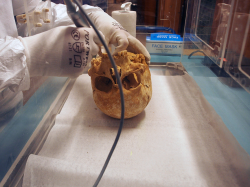 In relation to the ethnic and cultural change of the Carpathian Basin in the Early Middle Ages, not much attention has been paid to how settlers and local inhabitants co-existed and created a shared culture. Recent migration trends in Europe, however, have made it a hot topic to learn more about the migration wave that occurred 1500 years ago. Although history rarely provides clear guidelines to be followed, the unbiased observation of historical processes can broaden your perspective and help find better solutions.
In relation to the ethnic and cultural change of the Carpathian Basin in the Early Middle Ages, not much attention has been paid to how settlers and local inhabitants co-existed and created a shared culture. Recent migration trends in Europe, however, have made it a hot topic to learn more about the migration wave that occurred 1500 years ago. Although history rarely provides clear guidelines to be followed, the unbiased observation of historical processes can broaden your perspective and help find better solutions.
The complex multidisciplinary research project funded under the Researchers' Thematic Applications Programme of the NRDI Fund combines traditional and new methods to present a more accurate picture about how the population of the Carpathian Basin, including the territory of present-day Hungary, changed in the 5th to 7th centuries A.D., and how changes in lifestyle relate to the constant ethnic and cultural changes. However, artefacts found in tombs and the evolution of funeral and settlement traditions can supply us with not much of new information if we use traditional archaeological and anthropological methods. This is why the joint Hungarian–German bio-archaeological project seeks to find new ways of interpreting remains with the involvement of modern scientific procedures still less applied in Hungarian archaeology practices of the great migration period. This approach does not only help learn more about our cultural heritage from the era before the Hungarian Conquest and provide additional information to the self-concept of the population living in Hungary today, but it also helps better understand the permanent and timeless nature of migration. Who, when and why decide to leave? Who, why and how decide to stay?
The research team studies the skeletal remains found in several cemeteries of the period (in Budakalász, Kölked, Szeleste, Mözs etc.) to obtain new information about migration and changes in lifestyle that occurred through the lives of the individuals buried there. The health condition of the former Huns, Gepids, Lombards and Pannonian Avars is assessed on the basis of archaeological and physical analyses conducted by Hungarian researchers on an unprecedentedly large sample. The isotope diagnostics of the samples started in June 2016 in the framework of the parallel project of the Curt-Engelhorn Zentrum Archäometrie in Mannheim, led by Dr Corina Knipper. That project received more than EUR 300,000 from the German research financing institution Deutsche Forschunsgemeinschaft (DFG).
The isotope diagnostics help map the origins and mobility of individuals by analysing the strontium content of teeth and bones. The proportion of this element always characterises a certain geographical environment and, as it gets into waters and plants, leaves its traces in the bone tissues of locals consuming such food. At a young age, strontium is conserved in the dental enamel where it indicates the individual's place of origin throughout his or her life. In other types of bones, however, the bone tissue is continuously changing, therefore the proportion of strontium isotopes reflects the place of living during the years before his or her death. This method enables us to clearly distinguish between locals and first generation immigrants in a given environment, to reveal the relationship between persons moving together, and to identifiy whether non-locals came from the same place of origin. The route of migration can also be tracked by reconstructing the lifestyle and staple diet of individuals of different social status. This is indicated by the analysis of the stable carbon and nitrogen isotopes since they integrate into the bones and thus conserve the composition of trace elements of regularly consumed food. The proportion of carbon isotopes is determined by the type of photosynthesis of plants, enabling a clear distinction between the food of terrestrial and aquatic origin for instance, or the consumption of millet as a peculiarity. Presence of nitrogen in the organs implies the consumption of more meat and a higher level of social status accordingly.
Genetic examinations help determine more accurately the share of settlers and locals in a given community as well as the origin of newcomers. The DNA tests to be performed by the Laboratory of Archeogenetics, Institute of Archaeology, Research Centre for the Humanities, Hungarian Academy of Sciences are able to identify the various haplotypes (i.e. a group of genes inherited together from a single parent) which provide new and objective data of the composition of an ethnic group, the level of kinship between individuals as well as their migration routes. Analysing such information will provide a better understanding of the composition, relations and mobility of the social elite in the period of the Pannonian Avars.
The multidisciplinary evaluation of the results of different examinations gives rise to a new interpretation of history; the diversity of methods paves the way for a comprehensive reinterpretation of the archaeological finds of the migration period and the known phenomena. An international team with members from various generations of researchers cooperates combining the new aspects of related social sciences and modern disciplines.
Partner institutions:
-
Institute of Archaeological Sciences, Faculty of Humanities, Eötvös Loránd University, Budapest
-
Curt-Engelhorn Zentrum Archäometrie, Mannheim
-
Department of Biological Anthropology, Faculty of Science, Eötvös Loránd University, Budapest
-
Laboratory of Archeogenetics, Institute of Archaeology, Research Centre for the Humanities, Hungarian Academy of Sciences, Budapest
-
Department of Anthropology, Hungarian Natural History Museum, Budapest
-
Balaton Museum, Keszthely
-
Janus Pannonius Museum, Pécs
-
Savaria Museum, Szombathely
-
Wosinsky Mór County Museum, Szekszárd
Funded project: NN 113157
Mobility and transforming population in the Carpathian Basin during the 5th to 7th centuries A.D.: Changing Societies and Identities






